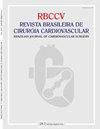冠状动脉搭桥术患者术前颈动脉双重扫描
IF 1.2
4区 医学
Q4 CARDIAC & CARDIOVASCULAR SYSTEMS
Revista Brasileira De Cirurgia Cardiovascular
Pub Date : 2019-12-01
DOI:10.21470/1678-9741-2019-0131
引用次数: 5
摘要
目的应用颈动脉双工超声分析冠状动脉旁路移植术(CABG)患者颈动脉狭窄(CAS)的发生率及危险因素。方法回顾性研究于2017年1月至2018年1月进行,纳入166例连续患者,其中男性130例(78.31%),女性36例(21.69%);平均年龄:64.25±9.78岁],接受选择性和孤立性冠脉搭桥。将显著CAS(≥50%狭窄)患者与非显著CAS(<50%狭窄)患者进行比较。对所选参数进行Logistic回归分析,以确定显著CAS的危险因素。结果36例(21.68%)颈动脉狭窄≥50%,8例(4.81%)单侧颈动脉狭窄≥70%。5例(3.01%)患者同时行颈动脉内膜切除术/CABG。这些患者在术后没有出现心脏和神经系统问题。CABG术后脑血管意外(CVA)总发生率为1.20% (n=2)。年龄(P=0.011)和CVA病史(P=0.035)在CAS≥50组显著高于CAS <50组。显著的CAS被认为是术后CVA的危险因素(P=0.013)。结论年龄和CVA病史是显著性CAS的危险因素。此外,显著的CAS被确定为术后CVA的危险因素。因此,即使在没有相关危险因素的情况下,也建议对CABG患者进行颈动脉筛查。本文章由计算机程序翻译,如有差异,请以英文原文为准。
Preoperative Carotid Duplex Scanning in Patients Undergoing Coronary Artery Bypass Grafting
Objective The aim of this study was to determine the prevalence and risk factors of carotid artery stenosis (CAS) using carotid duplex ultrasound in patients undergoing coronary artery bypass grafting (CABG). Methods This retrospective study was conducted between January 2017 and January 2018 and included 166 consecutive patients [130 males (78.31%), 36 females (21.69%); mean age: 64.25±9.78 years] who underwent elective and isolated CABG. Patients who had significant CAS (≥50% stenosis) were compared with patients who had non-significant CAS (<50% stenosis). Logistic regression analysis was applied across the selected parameters to identify risk factors for significant CAS. Results Of all patients, 36 (21.68%) had CAS ≥50% and 8 (4.81%) had unilateral carotid stenosis ≥70%. Carotid endarterectomy/CABG was performed simultaneously in five (3.01%) patients. None of these patients had cardiac and neurological problems during the postoperative period. The overall incidence of cerebrovascular accident (CVA) after CABG was 1.20% (n=2). Age (P=0.011) and history of CVA (P=0.035) were significantly higher in the CAS ≥50 group than in the CAS <50 group. Significant CAS was identified as a risk factor for postoperative CVA (P=0.013). Conclusion Age and history of CVA were identified as risk factors for significant CAS. Furthermore, significant CAS was identified as a risk factor for postoperative CVA. For this reason, carotid screening is recommended for patients undergoing CABG even in the absence of associated risk factors.
求助全文
通过发布文献求助,成功后即可免费获取论文全文。
去求助
来源期刊

Revista Brasileira De Cirurgia Cardiovascular
CARDIAC & CARDIOVASCULAR SYSTEMS-SURGERY
CiteScore
2.10
自引率
0.00%
发文量
176
审稿时长
20 weeks
期刊介绍:
Brazilian Journal of Cardiovascular Surgery (BJCVS) is the official journal of the Brazilian Society of Cardiovascular Surgery (SBCCV). BJCVS is a bimonthly, peer-reviewed scientific journal, with regular circulation since 1986.
BJCVS aims to record the scientific and innovation production in cardiovascular surgery and promote study, improvement and professional updating in the specialty. It has significant impact on cardiovascular surgery practice and related areas.
 求助内容:
求助内容: 应助结果提醒方式:
应助结果提醒方式:


